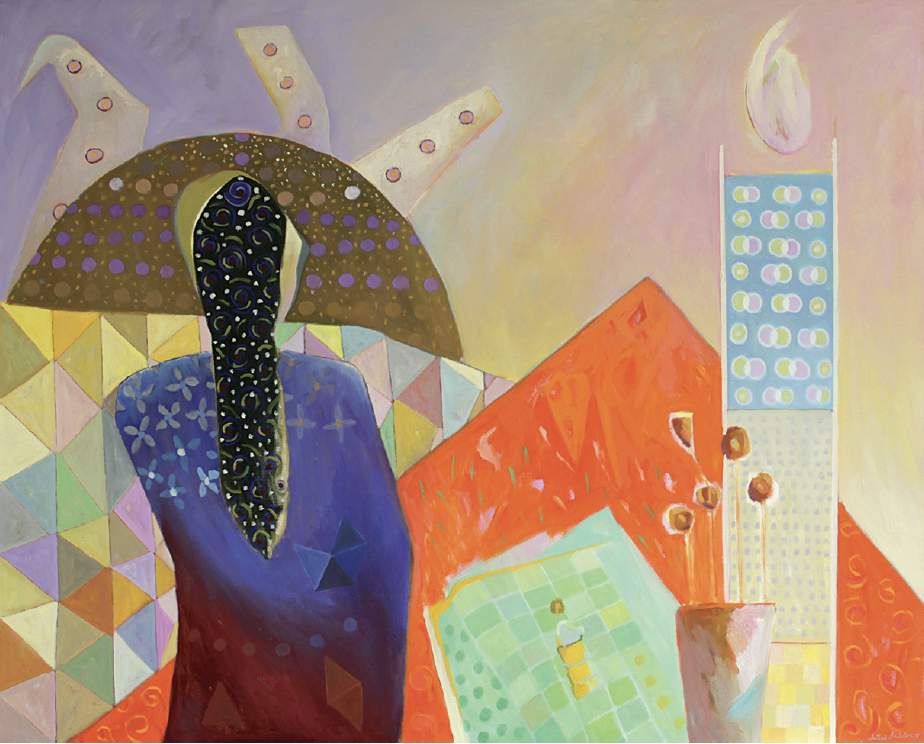Milos Milidrag
The concept of the inexpressibly transitory and fleeting, yet ironic and eternal return is celebrated metaphorically throughout the capricious imaginary landscapes of Milos Milidrag’s recent exhibition, “Forgotten Flowers,” at the Gurevich Gallery in Winnipeg in early spring, 2014. Indeed, the transient yet persistent mark of his make-believe frames within frames is a series of untitled but numbered storybook paintings. As fantastical as a butterfly’s wings or as illusory as the dragonfly’s, Milidrag’s “Forgotten Flowers” capture the phenomenological world of colour throughout the entire series. Here he pays homage to his mentors and teachers: Matisse, Klee, Kandinsky and Bonnard to name only a mirthful mouthful of influences. Meeting the quietly stoic and undemonstrative giant himself is perhaps as deceptive and incongruous as the paintings he paints. In “Forgotten Flowers” the ineffable worlds of colour and form collide in an expression of representation that remains an impossibility. His love of the primitive and the abstract are articulated through a series of contradictions and tensions in these works. Part of his motivation emerges from his need to hold to personal identifications and influences in his over 40 years of practice and devotion to a host of antecedents.

Milos Milidrag, Forgotten Flowers 6, 2013, oil on canvas, 44 x 54 inches. Courtesy Gurevich Fine Art, Winnipeg.
For him it is in the labour of forgetting that the place of nostalgia, memory and memor- ial lies. In this way the flowers that appear in the works are a nod to the transitory or to the only place of permanence, which is change. Arguably Milidrag pays homage to the traditional world of art history, and while marrying the postmodern world of the apocalyptic he simplifies by circling back to two-dimensional spaces on which, in some attempt at ordering, he applies his colours. Because Milidrag confesses that he cannot escape from his history of war feelings and that his consciousness will not allow him to rest, the holes and circles found juxtaposed against smooth surfaces and transparent figures act as personal reflection. The holes located in Forgotten Flowers #8 serve as an example; the circles and punctures are the holes in his heart. In the works in this exhibition the devastation and violence of his war experience is collaged in the fragments, which come unconsciously from his memories, since an absence is also a presence. He invokes images from the world of the Egyptians, Greek artisans and the Lascaux Cave paintings. In mixing Byzantine blues and pastels, he allows for an occult instability to arise between the anxiety and tensions of East-meets-West. In these paintings Milidrag never settles for a singular expression. He plays with Islamic arabesques and the circles and stick figures scratched on the surfaces of the cave paintings; certainly, he finds some peace in the past where he openly borrows and balances. As a practising painter and teacher, his works in “Forgotten Flowers” focus on colour as well as colour theory, where the mix he creates is what he calls “nouveaux cuisine” in the art world. Playing with paradox allows him to achieve and communicate the powerful concept of immortality and death established throughout the series.
His love of Inuit, Canadian art and First Nations artists is deeply felt and as significant to his practice as early Hellenistic and Greek sculpture. He invokes the second-century BC marble statue, Nike of Samothrace, and a female Inuit form also appears in his work. He shows a bawdy female figure, faceless and under the Muslim burka in Forgotten Flowers #1. By invoking the facelessness of women he moves away from the literal and here, woman becomes a meditation; thinking woman, a woman with depth and identity beyond the literal representation. The Inuit figure or Nike of Samothrace or the bawdy flapper are seen against a woman in a burka and speak to the anger he feels at the conventionalization of Hollywood readings of beauty and the subsequent imposition as images of beauty for all women.
Aside from a complex and critical portraiture of facelessness in the silhouetted women throughout his works, he is committed to the palatte of Matisse, the fragmented worlds of Picasso, Mondrian and the primitive works of Klee. His paintings materialize out of the liminal spaces of historiography, order and convention but he incorporates the ephemeral and momentary through a combination of trace, the nostalgia of disappearance and his imaginary landscapes. In speaking to Milidrag it becomes apparent that the central tenets surrounding his paintings link directly to his own and his family’s survival. The war was a terrifying experience he could neither escape nor forget. There are traces everywhere to remind him of this darkest period in his life. Bullet holes in the concrete buildings of his hometown of Sarajevo disturb and interrupt him and remind him of the brail of violence, of war-torn Bosnia, and of the marks left on those who survived the siege. None of the works are specifically titled, the referential best apprehended through ordering unconscious traumatic experiences—numbering and forgetting. ❚
“Forgotten Flowers” was exhibited at Gurevich Fine Art, Winnipeg, from April 4 to April 26, 2014.
Kim Olynyk lectures across disciplines.

